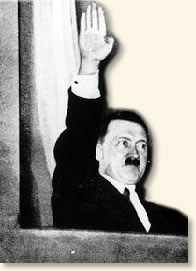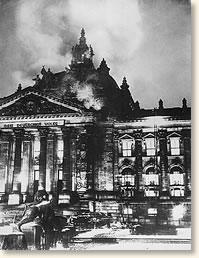|
The Reichstag Fire, 1933
The alarm was sounded on the evening of February 27, 1933 signaling not only a fire, but the arrival of a crucial moment in German history. The Reichstag Building in Berlin, the seat of the German Parliament, was ablaze. By the time firefighters arrived, the Reichstag was overwhelmed by the flames. In addition to destroying the physical embodiment of democracy in Germany, the conflagration provided the first step down a path that led to the solidification of Hitler's dictatorship and to the most devastating war the world has ever known. This pivotal inferno was no accident.
 |
Chancellor Adolph Hitler, 1933
|
In 1932 the democratic government of Germany, dictated by the Versailles Treaty at the close of World War One, was in political chaos. The Nazi Party was the largest political party within the Reichstag but did not have a majority of seats. After several failed attempts to form a new government in the latter part of that year, German President Hindenburg appointed Adolph Hitler Chancellor on January 30, 1933. Having achieved political power, Hitler and his Nazi cohorts looked for a way to solidify their position. The destruction of the Reichstag Building was their answer.
Evidence discovered after World War Two indicates that the fire that engulfed the Reichstag twenty-eight days after Hitler's ascendency to Chancellor was planned and executed by his henchmen, Herman Goering and Joseph Goebbels, Hitler publicly blamed the Communists, an accusation that allowed him to arrest the Communist members of the Reichstag and thereby eliminate his major political opposition. A young, mentally deranged Communist Dutchman by the name of Marinus van der Lubbe was arrested, tried and convicted of setting the fire.
In late March 1933, Hitler presented legislation to the Reichstag that would transfer its powers to himself. The members easily voted themselves out of existence and proclaimed Hitler the sole leader of Germany. His total control of the country was democratically reconfirmed the following year when, in a plebiscite, 90% of the voters approved of Hitler's dictatorial leadership. He was acclaimed as der Fueher. He had learned a bitter lesson years earlier when he sought to achieve power through violence and failed (see Adolph Hitler Attempts a Coup, 1923). Now, he attained his goal through the skillful use of the tools of democracy. A fire during the night of February 27, 1933 paved the way.
D. Sefton Delmar was a reporter for the London Daily Express who witnessed the fire. We join his account as Hitler exclaims his reaction to the inferno:
"'This is a God-given signal! If this fire, as I believe, turns out to be the handiwork of Communists, then there is nothing that shall stop us now crushing out this murder pest with an iron fist.'
Adolf Hitler, Fascist Chancellor of Germany, made this dramatic declaration in my presence tonight in the hall of the burning Reichstag building.
The fire broke out at 9:45 tonight in the Assembly Hall of the Reichstag.
It had been laid in five different corners and there is no doubt whatever that it was the handiwork of incendiaries.
One of the incendiaries, a man aged thirty, was arrested by the police as he came rushing out of the building, clad only in shoes and trousers, without shirt or coat, despite the icy cold in Berlin tonight.
Five minutes after the fire had broken out I was outside the Reichstag watching the flames licking their way up the great dome into the tower.
A cordon had been flung round the building and no one was allowed to pass it.
After about twenty minutes of fascinated watching I suddenly saw the famous black motor car of Adolf Hitler slide past, followed by another car containing his personal bodyguard.
I rushed after them and was just in time to attach myself to the fringe of Hitler's party as they entered the Reichstag.
 |
The Reichstag ablaze
February 27,1933
|
Never have I seen Hitler with such a grim and determined expression. His eyes, always a little protuberant, were almost bulging out of his head.
Captain Goering, his right-hand man, who is the Prussian Minister of the Interior, and responsible for all police affairs, joined us in the lobby. He had a very flushed and excited face.
'This is undoubtedly the work of Communists, Herr Chancellor,' he said.
'A number of Communist deputies were present here in the Reichstag twenty minutes before the fire broke out. We have succeeded in arresting one of the incendiaries.'
'Who is he?' Dr Goebbels, the propaganda chief of the Nazi Party, threw in.
'We do not know yet,' Captain Goering answered, with an. ominously determined look around his thin, sensitive mouth. 'But we shall squeeze it out of him, have no doubt, doctor.'
We went into a room. 'Here you can see for yourself, Herr Chancellor, the way they started the fire,' said Captain Goering, pointing out the charred remains of some beautiful oak paneling. 'They hung cloths soaked in petrol over the furniture here and set it alight.'
We strode across another lobby filled with smoke. The police barred the way. 'The candelabra may crash any moment, Herr Chancellor,' said a captain of the police, with his arms outstretched.
By a detour we next reached a part of the building which was actually in flames. Firemen were pouring water into the red mass.
Hitler watched them for a few moments, a savage fury blazing from his pale blue eyes.
Then we came upon Herr von Papen, urbane and debonair as ever.
Hitler stretched out his hand and uttered the threat against the Communists which I have already quoted. He then turned to Captain Goering. 'Are all the other public buildings safe?' he questioned.
'I have taken every precaution,' answered Captain Goering. 'The police are in the highest state of alarm, and every public building has been specially garrisoned. We are waiting for anything.'
It was then that Hitler turned to me. 'God grant,' he said, 'that this is the work of the Communists. You are witnessing the beginning of a great new epoch in German history. This fire is the beginning.'
And then something touched the rhetorical spring in his brain. 'You see this flaming building,' he said, sweeping his hand dramatically around him. 'If this Communist spirit got hold of Europe for but two months it would be all aflame like this building.'
By 12.30 the fire had been got under control. Two Press rooms were still alight, but there was no danger of the fire spreading.
Although the glass of the dome has burst and crashed to the ground the dome still stands.
So far it has not been possible to disentangle the charred debris and see whether the bodies of any incendiaries, who may have been trapped in the building, are among it.
At the Prussian Ministry of the Interior a special meeting was called late tonight by Captain Goering to discuss measures to be taken as a consequence of the fire.
The entire district from the Brandenburg Gate, on the west, to the River Spree, on the east, is isolated tonight by numerous cordons of police."
References:
This eyewitness account appeared in: Delmar, D. Sefton, London Daily Express, 2/28/33, reprinted in: Lewis, Jon E. The Mammoth Book of EyeWitness History, 2000 (2000); Schirer, William, The Rise and Fall of the Third Reich (1991); Tobias, Fritz, The Reichstag Fire (1964).
How To Cite This Article:
"The Reichstag Fire, 1933," EyeWitness to History, www.eyewitnesstohistory.com (2009).
| 





